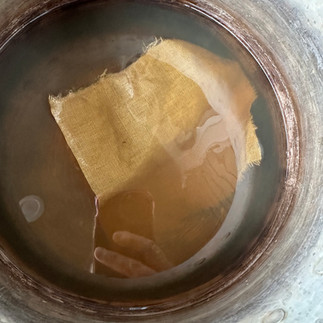
Iron (Ferrous sulfate) can shift the color of naturally dyed materials. The color change is described as saddening. Yellows often turn green, browns a darker brown, and reds maroon. It is a great way to extend the color pallet of your natural dyes.
The iron can react with the dye on your fabric, but it will also react with the tannin used to prepare plant-based fabrics. So, even an undyed fabric prepared with tannin will exhibit a gray color change.
Because iron can damage fibers, it should be used at a low ratio of 2-4 percent of the weight of fiber. The iron can be especially harsh on wool, and I typically only use it on plant-based fabrics.
Small splashes of iron can contaminate pots, spoons, drying racks, and fabric. Use great caution when working; if possible, dedicate a set of supplies to working with iron.

Prepare Iron Bath
Fill your pot with clean, hot water.
Add 2-4 percent of the weight of fiber of ferrous sulfate and stir until dissolved.
Wear gloves. The iron will turn your cuticles black and dry out your skin.
Place your wet, dyed material into the warm iron water.
Stir gently. Watch the color develop and remove once satisfied. I typically leave mine for 3-4 minutes.
Rinse well.






